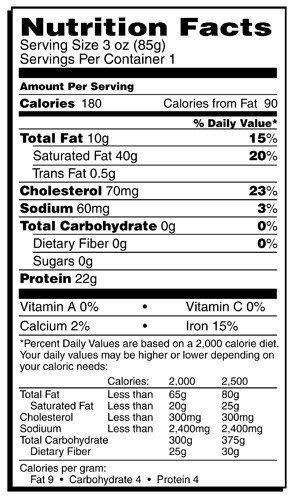The Importance of Food Labels
The food labels on the packages include information which provides total amounts of different nutrients per serving. To make wise food choices, check the total amounts for:

Total amounts are shown in grams, abbreviated as g, or in milligrams, shown as mg.
A gram is a very small weight unit.
One gram is one-thousandth of a kilogram or 35 thousandths of an ounce and a milligram is one-thousandth of one gram.
For example, a nickel weighs about 5 grams.
So does a teaspoonful of margarine.
Use the label to compare labels of similar foods.
For example, choose the product with a smaller amount of saturated fat, cholesterol, and sodium and try to select foods with more fiber.
Calories
The number of calories you eat counts, especially if you are trying to lose or maintain your weight.
If you want to lose weight you need to eat fewer calories than your body burns.
You can use the food labels to compare similar products and determine which contains fewer calories.
To find out how many calories you need each day, talk with your dietitian or certified diabetes educator.
Total fat
You can know how much fat is in a specific food per serving, according to details you have on its label.
Details include the good fats such as mono and polyunsaturated fats, and the bad fats such as saturated and trans fats.
Mono and polyunsaturated fats can help to lower your blood cholesterol and protect your heart.
Saturated and Trans fat can raise your blood cholesterol and increase your risk of heart disease.
The cholesterol in food may also increase your blood cholesterol.
Fat is calorie-dense. Per gram, it has more than twice the calories of carbohydrate or protein.
Although some types of fats, such as mono and polyunsaturated fats provide your body with healthy fats, it is still important to pay attention to the overall number of calories that you consume to maintain a healthy weight.
Sodium
When we are talking about sodium we mean actually salt or table salt, because table salt is very high in sodium and there are many foods which are salty, i.e. rich in sodium.
Many people eat much more sodium than they need.
Sodium does not affect blood glucose levels, but it can cause high blood pressure, so it may be helpful to eat less.
Notice that there is hidden salt in many foods, like cheeses, salad dressings, canned soups, in pickles or bacon and other packaged foods.
Reading food labels can help you compare the sodium in different foods.
You can also try using herbs and spices in cooking instead of adding salt.
Adults should aim for less than 2300 mg per day.
Total Carbohydrates
If you are carbohydrate counting, the food label can provide you with the information you need for meal planning.
Look at the grams of total carbohydrate, rather than the grams of sugar.
Total carbohydrate on the label includes sugar, complex carbohydrate, and fiber.
If you look only at the sugar number, you may end up excluding nutritious foods such as fruits and milks thinking they are too high in sugar.
You might also overeat foods such as cereals and grains that have no natural or added sugar, but do contain a lot of carbohydrate.
The grams of sugar and fiber are counted as part of the grams of total carbohydrate.
If a food has 5 grams or more fiber in a serving, subtract half the fiber grams from the total grams of carbohydrate for a more accurate estimate of the carbohydrate content.

Fiber
Fiber is part of plant foods that is not digested, or only partially digested for some types.
Fiber slows down the rate of carbohydrate digestion and reducing carbohydrate-induced elevations of blood sugar.
Many vegetables have fiber and also: whole-grain bread, cereals, crackers. bran, barley, bulgur, brown and wild rice, dried beans, peas, lentils, berries, and potatoes.
The recommendation is to eat 25-30 grams of fiber per day. People with diabetes need the same amount of fiber as everyone else for good health.
Sugar Alcohols
Sugar alcohols (also known as polyols) include sorbitol, xylitol and mannitol, and have fewer calories than sugars and starches.
Use of sugar alcohols in a product does not necessarily mean the product is low in carbohydrate or calories.
And, just because a package says "sugar-free" on the outside, that does not mean that it is calorie or carbohydrate-free. Always remember to check the food labels for the grams of carbohydrate and calories.
List of Ingredients
Ingredients are listed in descending order by weight, meaning the first ingredient makes up the largest proportion of the food.
Check the ingredient list to spot things you'd like to avoid, such as coconut oil or palm oil, which are high in saturated fat.
Also try to avoid hydrogenated oils that are high in trans fat.
They are not listed by total amount on the food label, but you can choose foods that don't list hydrogenated or partially hydrogenated oil in the ingredient list.
The ingredient list is also a good place to look for heart-healthy ingredients such as soy; monounsaturated fats such as olive, canola or peanut oils or whole grains, like whole wheat flour and oats.
|
Return from Food Labels Information to Diabetic Food |